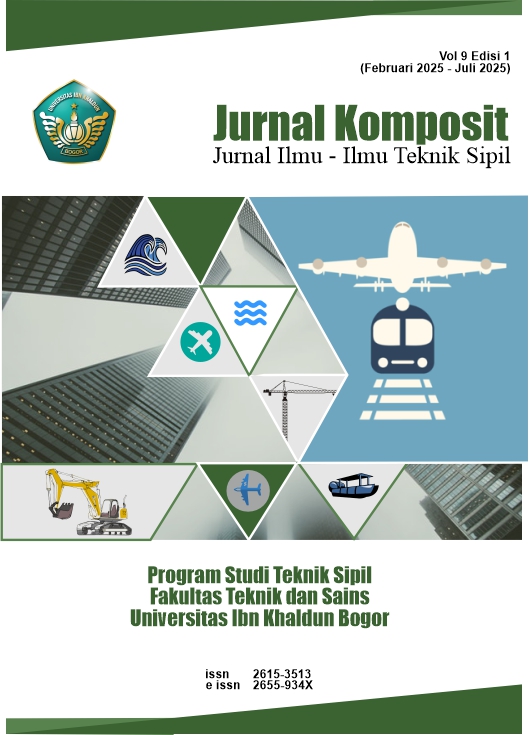Analisis Daya Serap Air Paving Block Plastik Polypropylene
DOI:
https://doi.org/10.32832/komposit.v9i1.17592Keywords:
Paving Block, Polypropylene Plastic, Water AbsorptionAbstract
Plastic waste in Balikpapan City accounts for 17% of the city's total waste production, ranking third after organic and paper waste. One category of waste that has received national and global attention is plastic waste. Plastic waste itself is difficult to decompose naturally and takes years, if the accumulation of plastic waste is allowed to drag on, it will cause many problems, such as disease and environmental pollution. Therefore, it is necessary to utilise plastic as one of the technological innovations in the field of construction, where this plastic can be used as a mixture in making paving. In this study, PP plastic was used as a substitute for cement in paving blocks. The purpose of this research is to assess whether paving blocks using a mixture of PP plastic and sand can fulfil the water absorption requirements according to SNI 03-0691-1996. The mixture used between PP plastic and sand is 10%, 30%, 50% with diamond shape with plastic melting temperature of 240○C. The absorption of paving blocks by utilising polypropylene plastic as a substitute for cement decreased as the percentage of PP plastic increased. The absorption of 10% plastic variation of the diamond meets quality B because it obtained an absorption value of 4.34%. While the addition of 30% and 50% plastic obtained a value below 3% which means it meets quality A in SNI 03-0691 (1996).
References
Achidah, F., Indriani, A. M., & Utomo, G. (2024). … Penambahan Cacahan Plastik Pet (Polytethylene Terephthalate) Pada Beton Menggunakan Agregat Kasar Batu Petangis Terhadap …. Media Bina Ilmiah, 18(1978), 1439–1442. http://binapatria.id/index.php/MBI/article/view/687
Agyeman, S., Obeng-Ahenkora, N. K., Assiamah, S., & Twumasi, G. (2019). Exploiting recycled plastic waste as an alternative binder for paving blocks production. Case Studies in Construction Materials, 11(2019), e00246. https://doi.org/10.1016/j.cscm.2019.e00246
Awodiji, C. T. ., Sule, S., & Oguguo, C. . (2022). Comparative study on the strength properties of paving blocks produced from municipal plastic waste. Nigerian Journal of Technology, 40(5), 762–770. https://doi.org/10.4314/njt.v40i5.1
Brizi, M. R. A., Rakhmawati, A., & Arnandha, Y. (2021). Pemanfaatan Limbah Plastik Ldpe Sebagai Bahan Campuran Pembuatan Bata Beton (Paving Block). Jurnal Rekayasa Infrastruktur Sipil, 1(2), 2–7. https://doi.org/10.31002/.v1i2.3521
Desyani, N. A., Yuwono, A. S., & Putra, H. (2023). Assessing the Performance of Melted Plastic as a Replacement for Sand in Paving Block. Advances in Technology Innovation, 8(3), 219–228. https://doi.org/10.46604/aiti.2023.11508
Kusuma, S. S., Andi Marini Indriani, & Gunaedy Utomo. (2024). Pengaruh Penggunaan Polyethylene Terephthalate sebagai Agregat Halus terhadap Kuat Lentur Beton. Jurnal Komposit: Jurnal Ilmu-Ilmu Teknik Sipil, 8(2), 249–254. https://doi.org/10.32832/komposit.v8i2.15097
Liang, M. S. M. W. H. (2021). Kajian Pengelolaan Sampah Plastik Sekali Pakai di Kota Balikpapan. 1–202.
Šešlija, M., Radović, N., Jovanov, D., Kukaras, D., Starčev-Ćurčin, A., & Jokanović, I. (2018). Possibilities of pervious concrete application in road construction. Tehnicki Vjesnik, 25(4), 1202–1212. https://doi.org/10.17559/TV-20160524162507
Sibuea, A. F., & Tarigan, J. (2013). Pemanfaatan Limbah Botol Plastik Sebagai Bahan Eco Plafie ( Economic Plastic Fiber ) Paving Block Yang Berkonsep Ramah Lingkungan Dengan Uji Tekan , Uji Kejut Dan Serapan Air. Jurnal Teknik Sipil USU, 2(2), 1–8.
Suardiana, I. W., Suardana, N. P. G., & Kencanawati, C. I. P. K. (2020). Pengaruh Waktu Perendaman Terhadap Daya Serap Air dan Keausan Pada Paving Block Plastik-Pasir. Prosiding Seminar Nasional Teknoka, 5(2502), 266–273. https://doi.org/10.22236/teknoka.v5i.350
Sultan, M. A., Tata, A., & Wanda, A. (2020). Penggunaan Limbah Plastik PP Sebagai Bahan Pengikat Pada Campuran Paving Block. Siklus : Jurnal Teknik Sipil, 6(2), 95–102. https://doi.org/10.31849/siklus.v6i2.4552
Supit, S., Priyono, Sirun, A., & Astanto, M. (2022). Study on Pervious Concrete Paving Block Containing Plastic Waste Type Pet As a Sand Replacement. Proceedings of International Structural Engineering and Construction, 9(2). https://doi.org/10.14455/ISEC.2022.9(2).MAT-20
Tempa, K., Chettri, N., Thapa, G., Phurba, Gyeltshen, C., Norbu, D., Gurung, D., & Wangchuk, U. (2022). An experimental study and sustainability assessment of plastic waste as a binding material for producing economical cement-less paver blocks. Engineering Science and Technology, an International Journal, 26, 101008. https://doi.org/10.1016/j.jestch.2021.05.012
Urbania, B. A., Dewi, T. U., & Nindyapuspa, A. (2022). Pengaruh Metode Perawatan Siram terhadap Kualitas Paving Block menggunakan Limbah Plastik HDPE – LDPE. Conference Proceeding on Waste Treatment Technology, 5(1), 102–106.
Wahyudi, Y., Andi Marini Indriani, & Gunaedy Utomo. (2024). Analisis Kuat Tekan Beton Modifikasi Polyethylene Terephthalate (Pet). Konferensi Nasional Teknik Sipil (KoNTekS), 1(6), 16–17. https://doi.org/10.62603/konteks.v1i6.133
Yazid, M., Rizki Ramadhan Husaini, & Gefry. (2023). Penggunaan Limbah Plastik Polypropylene sebagai Substitusi Semen pada Paving Block. Jurnal Teknologi Dan Rekayasa Sipil, 2(1), 34–38. https://doi.org/10.56208/jtrs.v2.i1-hal34-38
Downloads
Published
How to Cite
Issue
Section
License
Copyright (c) 2025 Jurnal Komposit: Jurnal Ilmu-ilmu Teknik Sipil

This work is licensed under a Creative Commons Attribution-NonCommercial-ShareAlike 4.0 International License.
Authors who publish with this journal agree to the following terms (Penulis yang mengajukan publikasi artikel telah menyetujui hal berikut):
- Through this publication, the author agree to submit the copyright of article writing to Jurnal Komposit: Jurnal Ilmu-ilmu Teknik Sipil. This copyright submission takes the form of, but is not limited to: reproduction of the article and parts therein, including photographic reproductions; distribution of articles through printed and electronic documents; and translation of articles(Bahwa melalui publikasi ini, hak cipta penulisan artikel diserahkan kepada Jurnal Komposit: Jurnal Ilmu-ilmu Teknik Sipil. Penyerahan hak cipta ini berupa, namun tidak terbatas pada: perbanyakan artikel dan bagian di dalamnya, termasuk reproduksi fotografi; penyebarluasan artikel melalui dokumen cetak dan elektronik; serta penterjemahan artikel).
- The authors agree to the terms of the Copyright Notice, according to Creative Commons Attribution-NonCommercial-ShareAlike 4.0 International License., which will apply to this article if and when it is published by Jurnal Komposit: Jurnal Ilmu-ilmu Teknik Sipil. (Para penulis setuju dengan ketentuan Pemberitahuan Hak Cipta, sesuai dengan Lisensi Internasional Creative Commons Attribution-NonCommercial-ShareAlike 4.0., yang akan berlaku untuk artikel ini jika dan ketika diterbitkan oleh Jurnal Komposit: Jurnal Ilmu-ilmu Teknik Sipil).

This work is licensed under a Creative Commons Attribution-NonCommercial-ShareAlike 4.0 International License.



.png)










